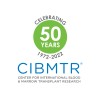
ORACLE: Observation of ResiduAl Cancer With Liquid Biopsy Evaluation
Bladder CarcinomaUreter Carcinoma13 moreThe purpose of ORACLE is to demonstrate the ability of a novel ctDNA assay developed by Guardant Health to detect recurrence in individuals treated for early-stage solid tumors. It is necessary that ctDNA test results are linked to clinical outcomes in order to demonstrate clinical validity for recurrence detection and explore its value in a healthcare environment subject to cost containment.

Monitoring Minimal Residual Disease of Patients With Acute Myelogenous Leukemia or High Grade Myelodysplastic...
Acute Myeloid LeukemiaMyelodysplastic SyndromeThis study is being performed to develop assays to determine the impact of the therapy patients receive for treatment of AML or MDS and to determine if these tests can identify those patients who are at a greater risk for having their disease relapse.

Measuring Molecular Residual Disease in Colorectal Cancer After Primary Surgery and Resection of...
Colorectal CancerResidual DiseaseCirculating tumour DNA (ctDNA) is a promising tool when monitoring the residual disease in colorectal cancer (CRC). Current staging procedures are insufficient to identify the patient cohort at high risk, who might benefit from additional adjuvant therapy. We will show that the assessment of ctDNA is a non-invasive approach and easily taken at different time points via simple blood draw to monitor residual disease from the colorectal cancer patients after primary surgery. Minimal residual disease could be used in the future for individualized treatment decisions after primary surgery.

Monitoring Minimal Residual Disease in Gastric Cancer by Liquid Biopsy Study Description
Gastric CancerctDNAThis study aims to evaluate the use of Next Generation Sequencing (NGS) to detect circulating tumor DNA in gastric cancer patients after gastrectomy

CPX-351 Versus Immediate Stem Cell Transplantation for the Treatment of High-Grade Myeloid Cancers...
Acute Myeloid LeukemiaMyelodysplastic Syndrome With Excess Blasts-21 moreThis phase II trial studies the effect of CPX-351 followed by donor stem cell transplantation versus immediate donor stem cell transplantation in treating patients with high-grade myeloid cancers with measurable residual disease. Chemotherapy drugs, such as CPX-351, work in different ways to stop the growth of tumor cells, either by killing the cells, by stopping them from dividing, or by stopping them from spreading. Giving chemotherapy before donor stem cell transplantation may help kill cancer cells in the body and make room in the patient's bone marrow for new blood-forming cells (stem cells) to grow.

Moxetumomab Pasudotox (CAT-8015, HA22) in Children With B-lineage Acute Lymphoblastic Leukemia and...
Acute Lymphoblastic Leukemia (ALL)This is a phase II, open-label, nonrandomized, prospective study to evaluate the activity, safety, and feasibility of administration of moxetumomab pasudotox in the pre-allogeneic hematopoietic cell transplantation (HCT) setting to patients with B-lineage Acute Lymphoblastic Leukemia (ALL) who are in a morphologic complete remission and have pre-transplant minimal residual disease (MRD) > 0.01% (detected by flow cytometry). The primary objective of this study is to determine if treatment with moxetumomab pasudotox in the MRD positive setting is able to lead to MRD negativity (< 0.01% by flow cytometry) or at least a 1-log10 reduction in MRD prior to allogeneic HCT.

Clofarabine and Cytarabine in Treating Patients With Acute Myeloid Leukemia With Minimal Residual...
Adult Acute Myeloid Leukemia in RemissionAdult Acute Myeloid Leukemia With 11q23 (MLL) Abnormalities5 moreRATIONALE: Drugs used in chemotherapy, such as clofarabine and cytarabine, work in different ways to stop the growth of cancer cells, either by killing the cells or by stopping them from dividing. Giving clofarabine together with cytarabine may kill more cancer cells. PURPOSE: This pilot phase II trial is studying how well giving clofarabine together with cytarabine works in treating patients with acute myeloid leukemia with minimal residual disease

Minimal Residual Disease in Peripheral T-cell Lymphoma
Peripheral T Cell LymphomaAs T-cell receptor sequencing by LymphoTrack is an assay with high sensitivity that can be performed in peripheral blood, the investigators wish to evaluate the ability of this assay to predict which patients are at higher risk of relapse after initial therapy for peripheral T-cell lymphomas which is being given for curative intent. Additionally, as more is known about the ability of dynamic monitoring of cfDNA in B-cell lymphomas to predict relapse, the investigators wish to explore the use of this technology in T-cell lymphomas.

Effect of Blinatumomab on Minimal Residual Disease (MRD) in Diffuse Large B-Cell Lymphoma (DLBCL)...
High-risk Diffuse Large B-cell LymphomaThe study will estimate the MRD-negative response rate after treatment with blinatumomab in subjects with high-risk DLBCL who are MRD-positive following aHSCT. The clinical hypothesis is that the MRD-negative response rate will be greater than 10%. Achieving an MRD-negative response rate of 30% would be of scientific and clinical interest.

Clofarabine With Cytarabine for Patients With Minimal Residual Disease Positive Leukemia
Minimal Residual DiseaseLeukemia5 moreThis study will test the ability of clofarabine + cytarabine to eliminate minimal residual disease (MRD) in acute myelogenous leukemia (AML) and acute lymphoblastic leukemia (ALL) patients whose bone marrows exhibit complete remission by morphology. The toxicity profile of this regimen will be evaluated in addition to toxicity experienced by patients who proceed to stem cell transplant. Overall length of remission will also be collected.
